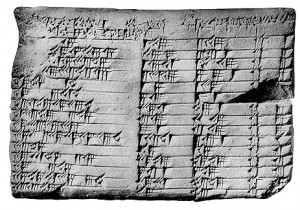Earliest Evidence of Pythagoras’ Theorem
To answer the question of what is the first evidenced knowledge of the familiar equation, a^2 + b^2 = c^2, named after the Greek philosopher Pythagoras (569-500 B.C.E.), depends on who you ask.
Credit for this geometrical proof has been attributed to, of course, namesake Pythagoras, but also to the ancient Babylonians via the tablet Plimpton 322, the ancient Chinese from the Zhou Bi Suan Jing (c. 100 B.C.E.- c. 100 C.E.), the Indian mathematician Bhaskara, and to Euclid who included a variation in his text The Elements.
Though the jury may be out on the rightful owner of being the first, it is evident that the ancients understood the theorem before Pythagoras got around to writing his proof.
The Chinese mathematics text,

The Zhou Bi Suan Jing (周髀算经) is a book called The Arithmetical Classic of the Gnomon and the Circular Paths of Heaven. It is one of the oldest of Chinese mathmatical texts.
Compilation of the contents took place first in the Zhou Dynasty (1046 BCE—256 BCE), and continued into the Western Han Dynasty (202 BCE – 220 CE). Its contents include 246 problems, along with the corresponding answers and arithmetic algorithms. Found within this collection is a recorded proof of the Pythagorean Theorem.
Another example is found in the Plimpton 322. The Babylonian tablet was written sometime around 1800 BCE in ancient Iraq (also called Mesopotamia). It is housed at Columbia and has a table consisting of fifteen columns of Pythagorean triples. Triples are a set of three positive integers a, b and c, where a2 = b2 + c2

Sources: Zhou Bi Suan Jing , http://www.maa.org/news/monthly105-120.pdf
